sensor INFINITI QX50 2020 Owner's Manual
[x] Cancel search | Manufacturer: INFINITI, Model Year: 2020, Model line: QX50, Model: INFINITI QX50 2020Pages: 580, PDF Size: 7.43 MB
Page 5 of 580
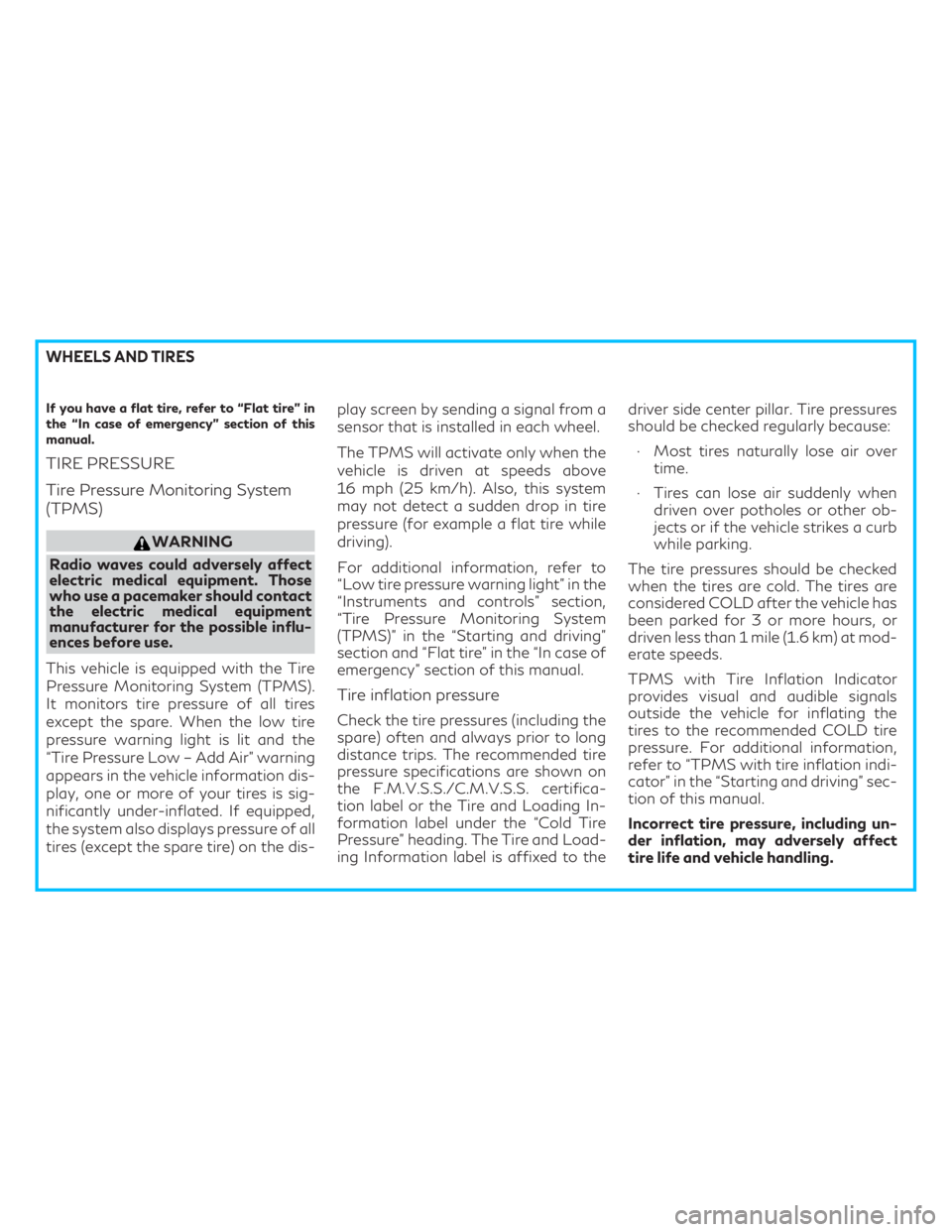
If you have a flat tire, refer to “Flat tire” in
the “In case of emergency” section of this
manual.
TIRE PRESSURE
Tire Pressure Monitoring System
(TPMS)
WARNING
Radio waves could adversely affect
electric medical equipment. Those
who use a pacemaker should contact
the electric medical equipment
manufacturer for the possible influ-
ences before use.
This vehicle is equipped with the Tire
Pressure Monitoring System (TPMS).
It monitors tire pressure of all tires
except the spare. When the low tire
pressure warning light is lit and the
“Tire Pressure Low – Add Air” warning
appears in the vehicle information dis-
play, one or more of your tires is sig-
nificantly under-inflated. If equipped,
the system also displays pressure of all
tires (except the spare tire) on the dis- play screen by sending a signal from a
sensor that is installed in each wheel.
The TPMS will activate only when the
vehicle is driven at speeds above
16 mph (25 km/h). Also, this system
may not detect a sudden drop in tire
pressure (for example a flat tire while
driving).
For additional information, refer to
“Low tire pressure warning light” in the
“Instruments and controls” section,
“Tire Pressure Monitoring System
(TPMS)” in the “Starting and driving”
section and “Flat tire” in the “In case of
emergency” section of this manual.
Tire inflation pressure
Check the tire pressures (including the
spare) often and always prior to long
distance trips. The recommended tire
pressure specifications are shown on
the F.M.V.S.S./C.M.V.S.S. certifica-
tion label or the Tire and Loading In-
formation label under the “Cold Tire
Pressure” heading. The Tire and Load-
ing Information label is affixed to thedriver side center pillar. Tire pressures
should be checked regularly because:
∙ Most tires naturally lose air over time.
∙ Tires can lose air suddenly when driven over potholes or other ob-
jects or if the vehicle strikes a curb
while parking.
The tire pressures should be checked
when the tires are cold. The tires are
considered COLD after the vehicle has
been parked for 3 or more hours, or
driven less than 1 mile (1.6 km) at mod-
erate speeds.
TPMS with Tire Inflation Indicator
provides visual and audible signals
outside the vehicle for inflating the
tires to the recommended COLD tire
pressure. For additional information,
refer to “TPMS with tire inflation indi-
cator” in the “Starting and driving” sec-
tion of this manual.
Incorrect tire pressure, including un-
der inflation, may adversely affect
tire life and vehicle handling.
WHEELS AND TIRES
Page 18 of 580
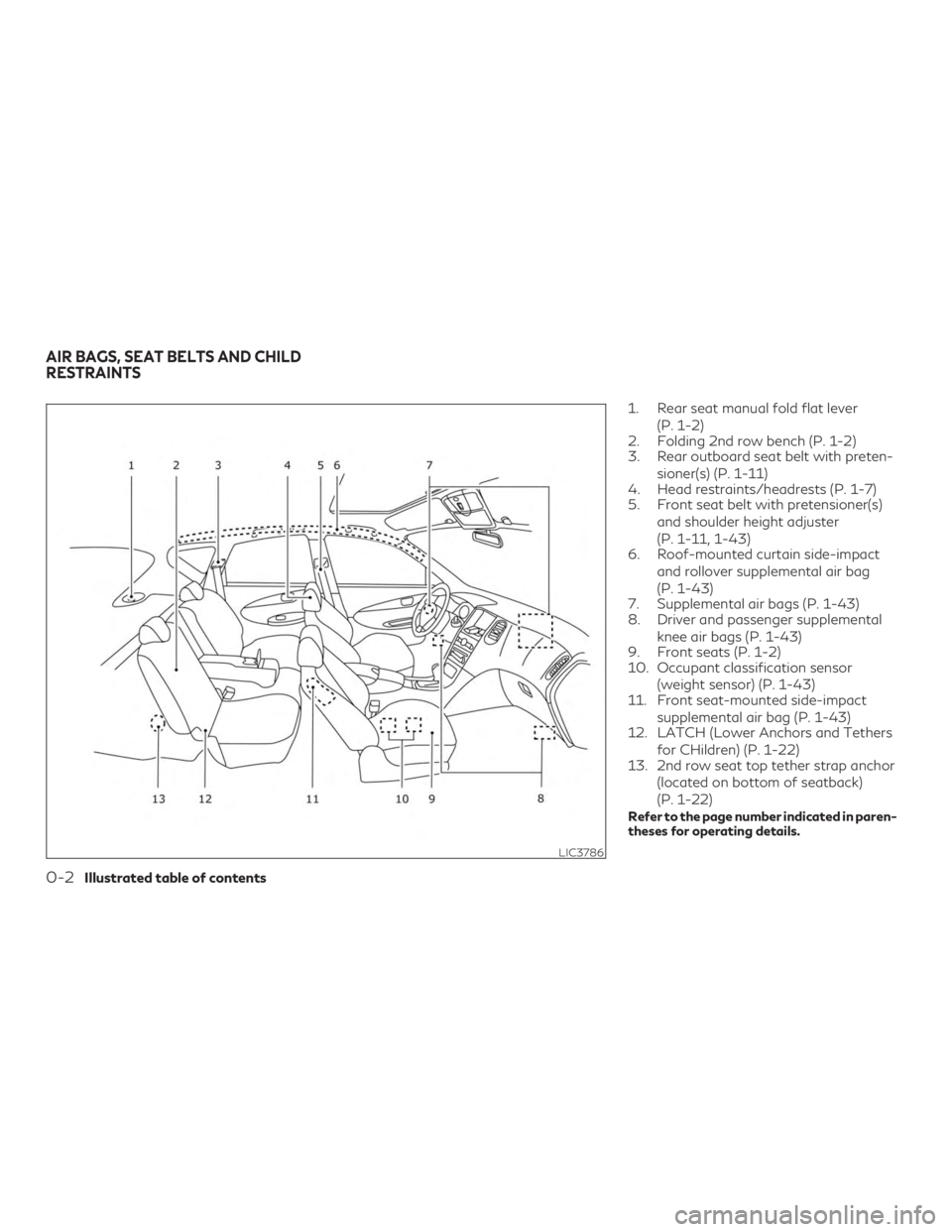
1. Rear seat manual fold flat lever(P. 1-2)
2. Folding 2nd row bench (P. 1-2)
3. Rear outboard seat belt with preten-
sioner(s) (P. 1-11)
4. Head restraints/headrests (P. 1-7)
5. Front seat belt with pretensioner(s)
and shoulder height adjuster
(P. 1-11, 1-43)
6. Roof-mounted curtain side-impact
and rollover supplemental air bag
(P. 1-43)
7. Supplemental air bags (P. 1-43)
8. Driver and passenger supplemental
knee air bags (P. 1-43)
9. Front seats (P. 1-2)
10. Occupant classification sensor
(weight sensor) (P. 1-43)
11. Front seat-mounted side-impact
supplemental air bag (P. 1-43)
12. LATCH (Lower Anchors and Tethers
for CHildren) (P. 1-22)
13. 2nd row seat top tether strap anchor
(located on bottom of seatback)
(P. 1-22)
Refer to the page number indicated in paren-
theses for operating details.
LIC3786
AIR BAGS, SEAT BELTS AND CHILD
RESTRAINTS
0-2Illustrated table of contents
Page 19 of 580
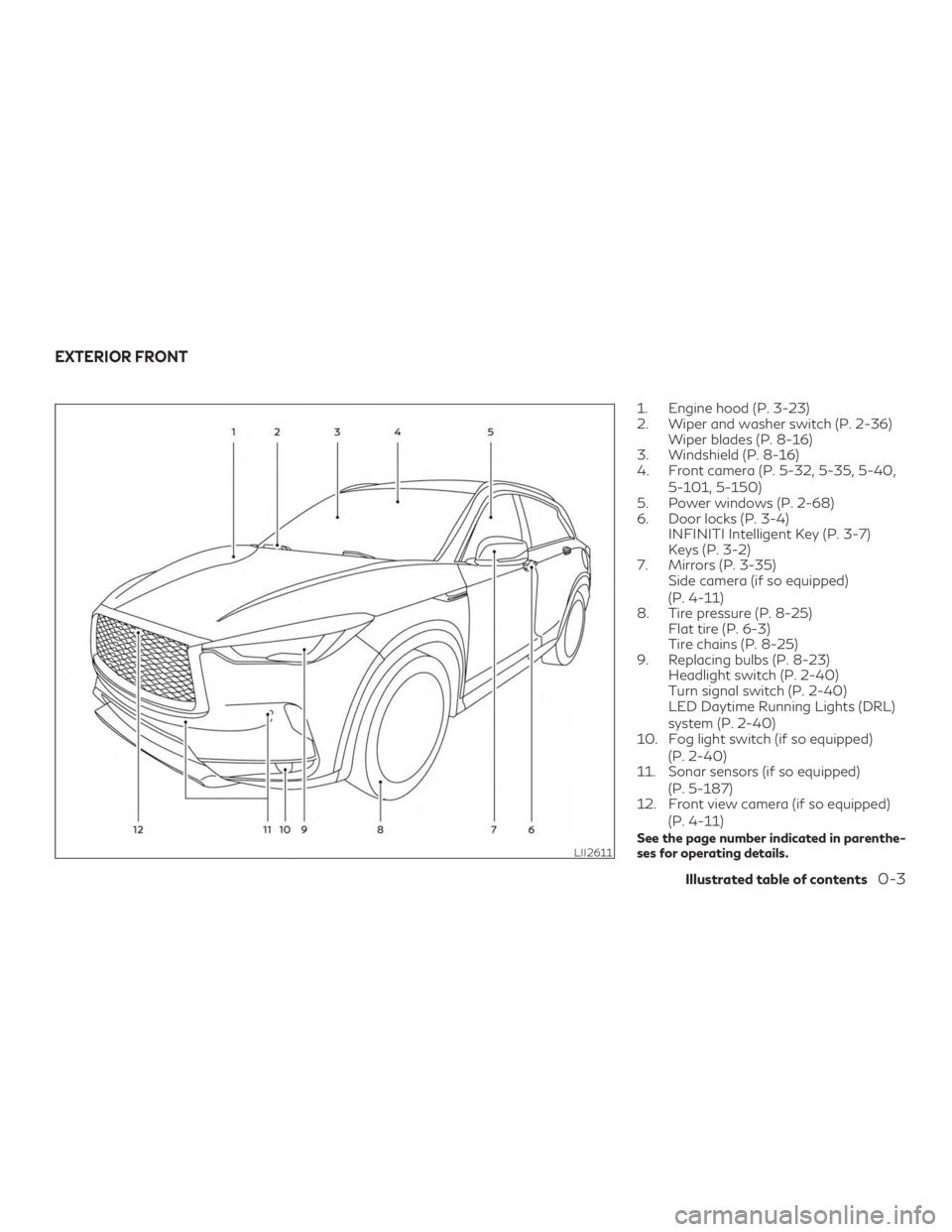
1. Engine hood (P. 3-23)
2. Wiper and washer switch (P. 2-36)Wiper blades (P. 8-16)
3. Windshield (P. 8-16)
4. Front camera (P. 5-32, 5-35, 5-40,
5-101, 5-150)
5. Power windows (P. 2-68)
6. Door locks (P. 3-4) INFINITI Intelligent Key (P. 3-7)
Keys (P. 3-2)
7. Mirrors (P. 3-35) Side camera (if so equipped)
(P. 4-11)
8. Tire pressure (P. 8-25) Flat tire (P. 6-3)
Tire chains (P. 8-25)
9. Replacing bulbs (P. 8-23) Headlight switch (P. 2-40)
Turn signal switch (P. 2-40)
LED Daytime Running Lights (DRL)
system (P. 2-40)
10. Fog light switch (if so equipped)
(P. 2-40)
11. Sonar sensors (if so equipped)
(P. 5-187)
12. Front view camera (if so equipped)
(P. 4-11)
See the page number indicated in parenthe-
ses for operating details.LII2611
EXTERIOR FRONT
Illustrated table of contents0-3
Page 20 of 580
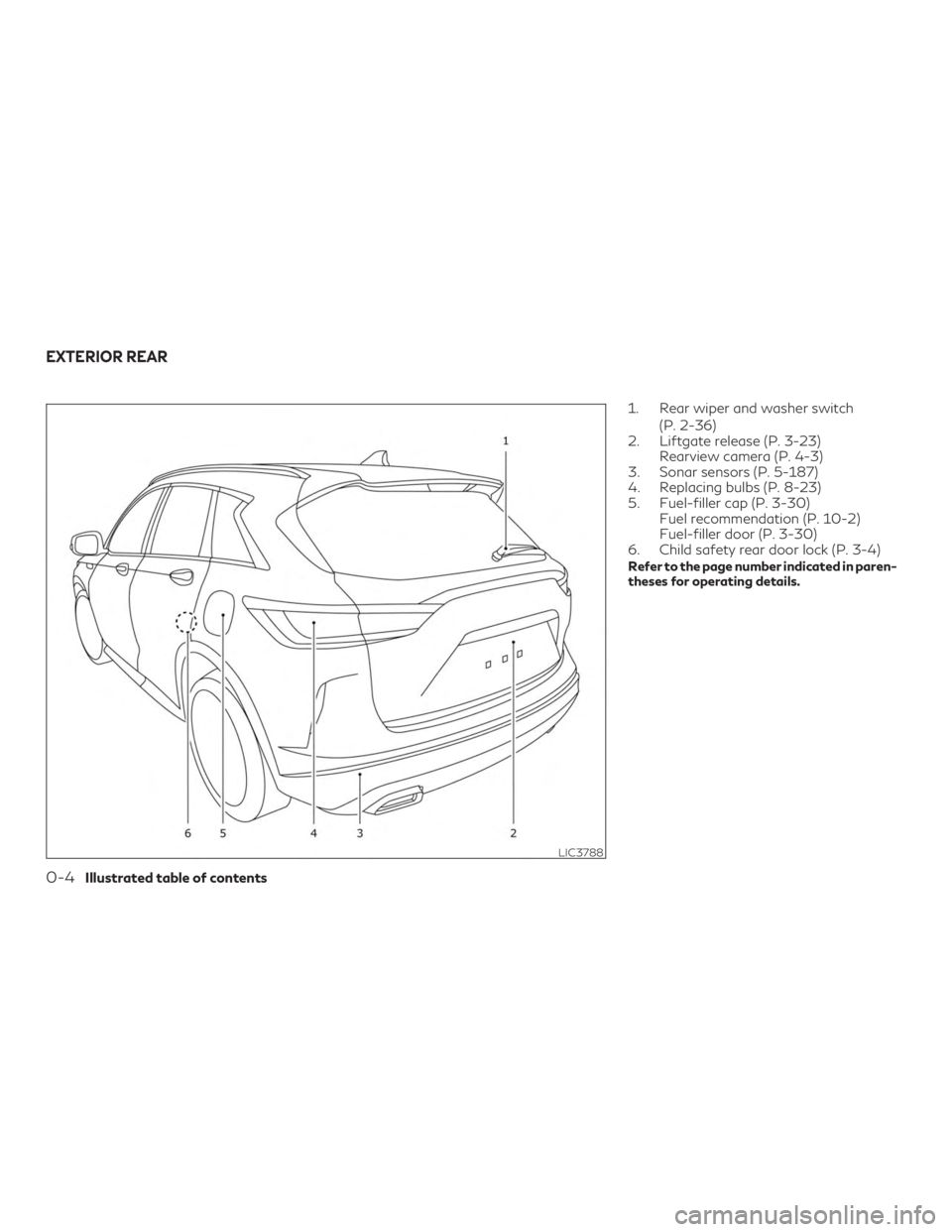
1. Rear wiper and washer switch(P. 2-36)
2. Liftgate release (P. 3-23) Rearview camera (P. 4-3)
3. Sonar sensors (P. 5-187)
4. Replacing bulbs (P. 8-23)
5. Fuel-filler cap (P. 3-30) Fuel recommendation (P. 10-2)
Fuel-filler door (P. 3-30)
6. Child safety rear door lock (P. 3-4)
Refer to the page number indicated in paren-
theses for operating details.
LIC3788
EXTERIOR REAR
0-4Illustrated table of contents
Page 71 of 580

WARNING
∙ The front air bags ordinarily will not in-flate in the event of a side impact, rear
impact, rollover, or lower severity frontal
collision. Always wear your seat belts to
help reduce the risk or severity of injury in
various kinds of accidents.
∙ The front passenger air bag will not in- flate if the passenger air bag status light
is lit. For additional information, refer to
“Front passenger air bag and status
light” in this section. ∙ The seat belts and the front air bags are
most effective when you are sitting well
back and upright in the seat. The front air
bags inflate with great force. Even with
the INFINITI Advanced Air Bag System, if
you are unrestrained, leaning forward,
sitting sideways or out of position in any
way, you are at greater risk of injury or
death in a crash. You may also receive
serious or fatal injuries from the front air
bag if you are up against it when it in-
flates. Always sit back against the seat-
back and as far away as practical from
the steering wheel or instrument panel.
Always properly use the seat belts. ∙ The driver and front passenger seat belt
buckles are equipped with sensors that
detect if the seat belts are fastened. The
INFINITI Advanced Air Bag System
monitors the severity of a collision and
seat belt usage then inflates the air bags
as needed. Failure to properly wear seat
belts can increase the risk or severity of
injury in an accident.
∙ The front passenger seat is equipped with an occupant classification sensor
(weight sensor) that turns the front pas-
senger air bag OFF under some condi-
tions. This sensor is only used in this seat.
Failure to be properly seated and wear-
ing the seat belt can increase the risk or
severity of injury in an accident. For addi-
tional information, refer to “Front pas-
senger air bag and status light” in this
section.
∙ Keep hands on the outside of the steering wheel. Placing them inside the steering
wheel rim could increase the risk that
they are injured when the front air bag
inflates.
WRS0031
Safety—Seats, seat belts and supplemental restraint system1-45
Page 77 of 580
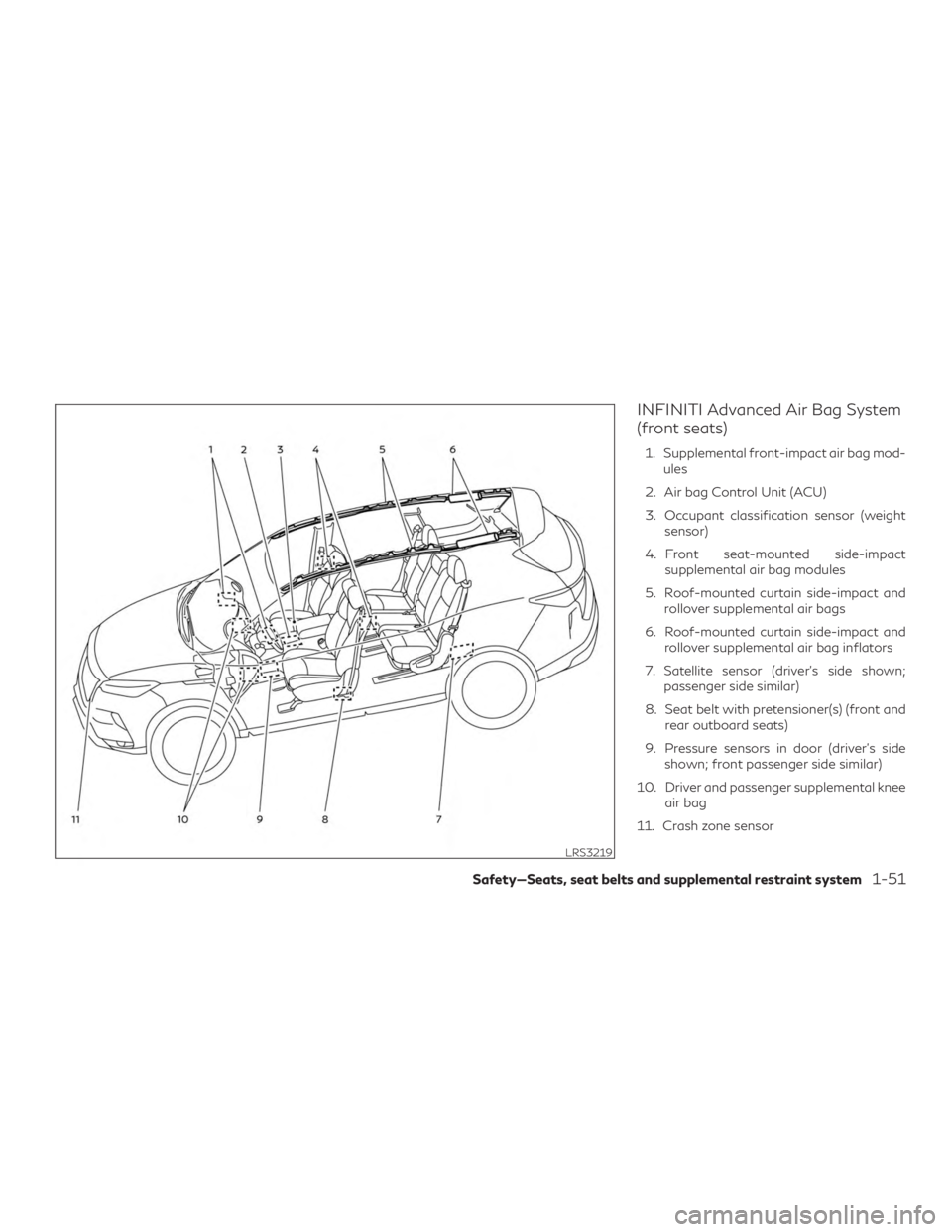
INFINITI Advanced Air Bag System
(front seats)
1. Supplemental front-impact air bag mod-ules
2. Air bag Control Unit (ACU)
3. Occupant classification sensor (weight sensor)
4. Front seat-mounted side-impact supplemental air bag modules
5. Roof-mounted curtain side-impact and rollover supplemental air bags
6. Roof-mounted curtain side-impact and rollover supplemental air bag inflators
7. Satellite sensor (driver’s side shown; passenger side similar)
8. Seat belt with pretensioner(s) (front and rear outboard seats)
9. Pressure sensors in door (driver’s side shown; front passenger side similar)
10. Driver and passenger supplemental knee air bag
11. Crash zone sensor
LRS3219
Safety—Seats, seat belts and supplemental restraint system1-51
Page 78 of 580
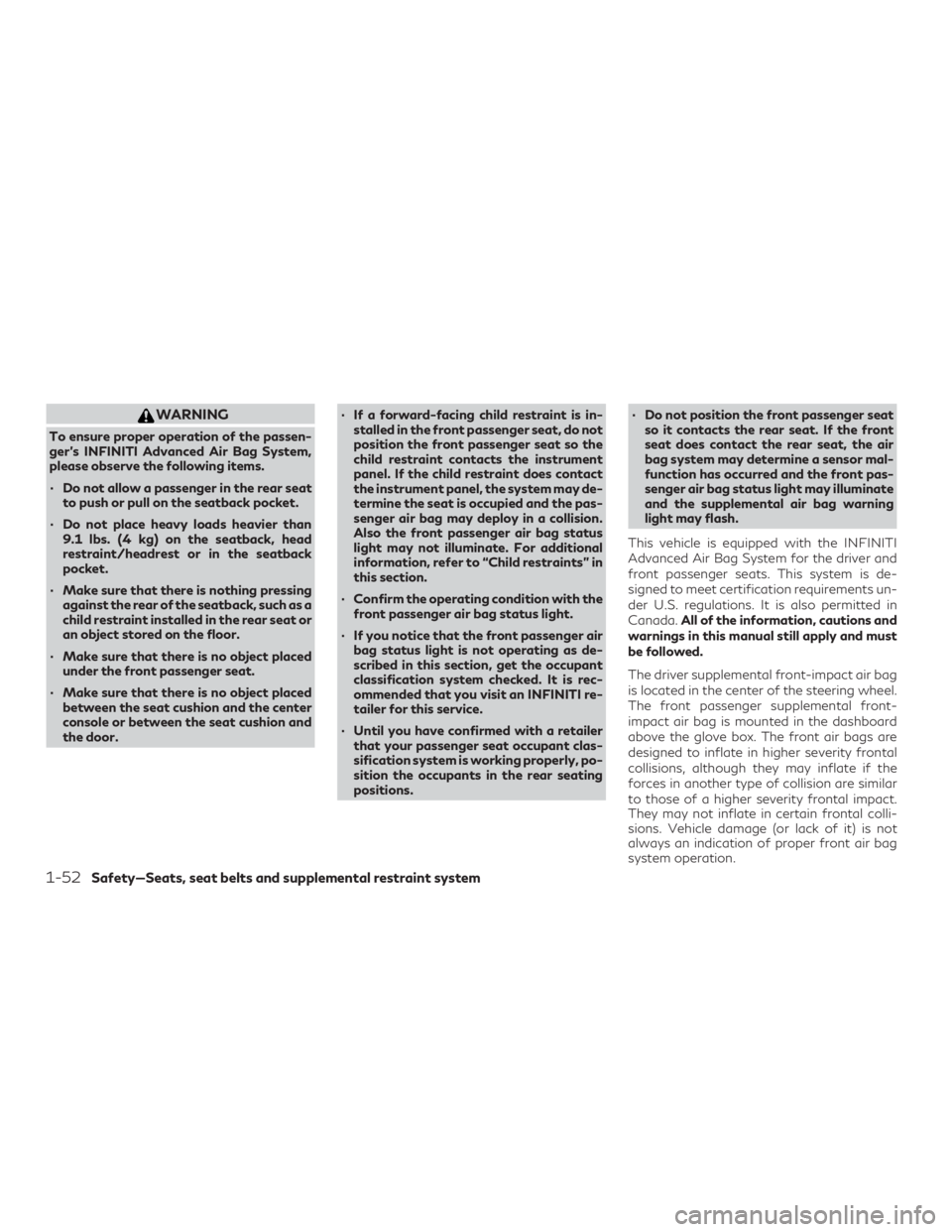
WARNING
To ensure proper operation of the passen-
ger’s INFINITI Advanced Air Bag System,
please observe the following items.
∙ Do not allow a passenger in the rear seatto push or pull on the seatback pocket.
∙ Do not place heavy loads heavier than 9.1 lbs. (4 kg) on the seatback, head
restraint/headrest or in the seatback
pocket.
∙ Make sure that there is nothing pressing against the rear of the seatback, such as a
child restraint installed in the rear seat or
an object stored on the floor.
∙ Make sure that there is no object placed under the front passenger seat.
∙ Make sure that there is no object placed between the seat cushion and the center
console or between the seat cushion and
the door. ∙ If a forward-facing child restraint is in-
stalled in the front passenger seat, do not
position the front passenger seat so the
child restraint contacts the instrument
panel. If the child restraint does contact
the instrument panel, the system may de-
termine the seat is occupied and the pas-
senger air bag may deploy in a collision.
Also the front passenger air bag status
light may not illuminate. For additional
information, refer to “Child restraints” in
this section.
∙ Confirm the operating condition with the front passenger air bag status light.
∙ If you notice that the front passenger air bag status light is not operating as de-
scribed in this section, get the occupant
classification system checked. It is rec-
ommended that you visit an INFINITI re-
tailer for this service.
∙ Until you have confirmed with a retailer that your passenger seat occupant clas-
sification system is working properly, po-
sition the occupants in the rear seating
positions. ∙ Do not position the front passenger seat
so it contacts the rear seat. If the front
seat does contact the rear seat, the air
bag system may determine a sensor mal-
function has occurred and the front pas-
senger air bag status light may illuminate
and the supplemental air bag warning
light may flash.
This vehicle is equipped with the INFINITI
Advanced Air Bag System for the driver and
front passenger seats. This system is de-
signed to meet certification requirements un-
der U.S. regulations. It is also permitted in
Canada. All of the information, cautions and
warnings in this manual still apply and must
be followed.
The driver supplemental front-impact air bag
is located in the center of the steering wheel.
The front passenger supplemental front-
impact air bag is mounted in the dashboard
above the glove box. The front air bags are
designed to inflate in higher severity frontal
collisions, although they may inflate if the
forces in another type of collision are similar
to those of a higher severity frontal impact.
They may not inflate in certain frontal colli-
sions. Vehicle damage (or lack of it) is not
always an indication of proper front air bag
system operation.
1-52Safety—Seats, seat belts and supplemental restraint system
Page 79 of 580
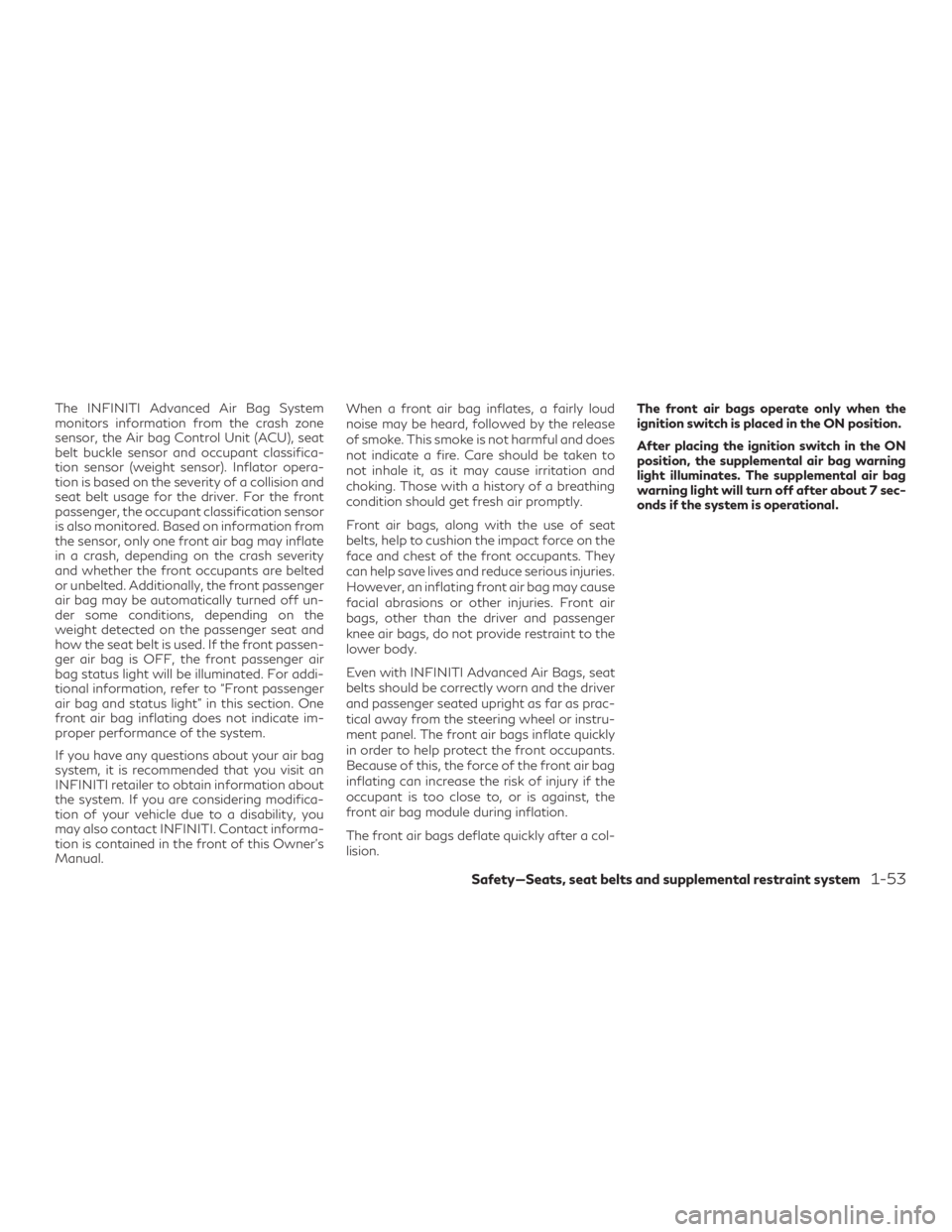
The INFINITI Advanced Air Bag System
monitors information from the crash zone
sensor, the Air bag Control Unit (ACU), seat
belt buckle sensor and occupant classifica-
tion sensor (weight sensor). Inflator opera-
tion is based on the severity of a collision and
seat belt usage for the driver. For the front
passenger, the occupant classification sensor
is also monitored. Based on information from
the sensor, only one front air bag may inflate
in a crash, depending on the crash severity
and whether the front occupants are belted
or unbelted. Additionally, the front passenger
air bag may be automatically turned off un-
der some conditions, depending on the
weight detected on the passenger seat and
how the seat belt is used. If the front passen-
ger air bag is OFF, the front passenger air
bag status light will be illuminated. For addi-
tional information, refer to “Front passenger
air bag and status light” in this section. One
front air bag inflating does not indicate im-
proper performance of the system.
If you have any questions about your air bag
system, it is recommended that you visit an
INFINITI retailer to obtain information about
the system. If you are considering modifica-
tion of your vehicle due to a disability, you
may also contact INFINITI. Contact informa-
tion is contained in the front of this Owner’s
Manual.When a front air bag inflates, a fairly loud
noise may be heard, followed by the release
of smoke. This smoke is not harmful and does
not indicate a fire. Care should be taken to
not inhale it, as it may cause irritation and
choking. Those with a history of a breathing
condition should get fresh air promptly.
Front air bags, along with the use of seat
belts, help to cushion the impact force on the
face and chest of the front occupants. They
can help save lives and reduce serious injuries.
However, an inflating front air bag may cause
facial abrasions or other injuries. Front air
bags, other than the driver and passenger
knee air bags, do not provide restraint to the
lower body.
Even with INFINITI Advanced Air Bags, seat
belts should be correctly worn and the driver
and passenger seated upright as far as prac-
tical away from the steering wheel or instru-
ment panel. The front air bags inflate quickly
in order to help protect the front occupants.
Because of this, the force of the front air bag
inflating can increase the risk of injury if the
occupant is too close to, or is against, the
front air bag module during inflation.
The front air bags deflate quickly after a col-
lision.
The front air bags operate only when the
ignition switch is placed in the ON position.
After placing the ignition switch in the ON
position, the supplemental air bag warning
light illuminates. The supplemental air bag
warning light will turn off after about 7 sec-
onds if the system is operational.
Safety—Seats, seat belts and supplemental restraint system1-53
Page 80 of 580
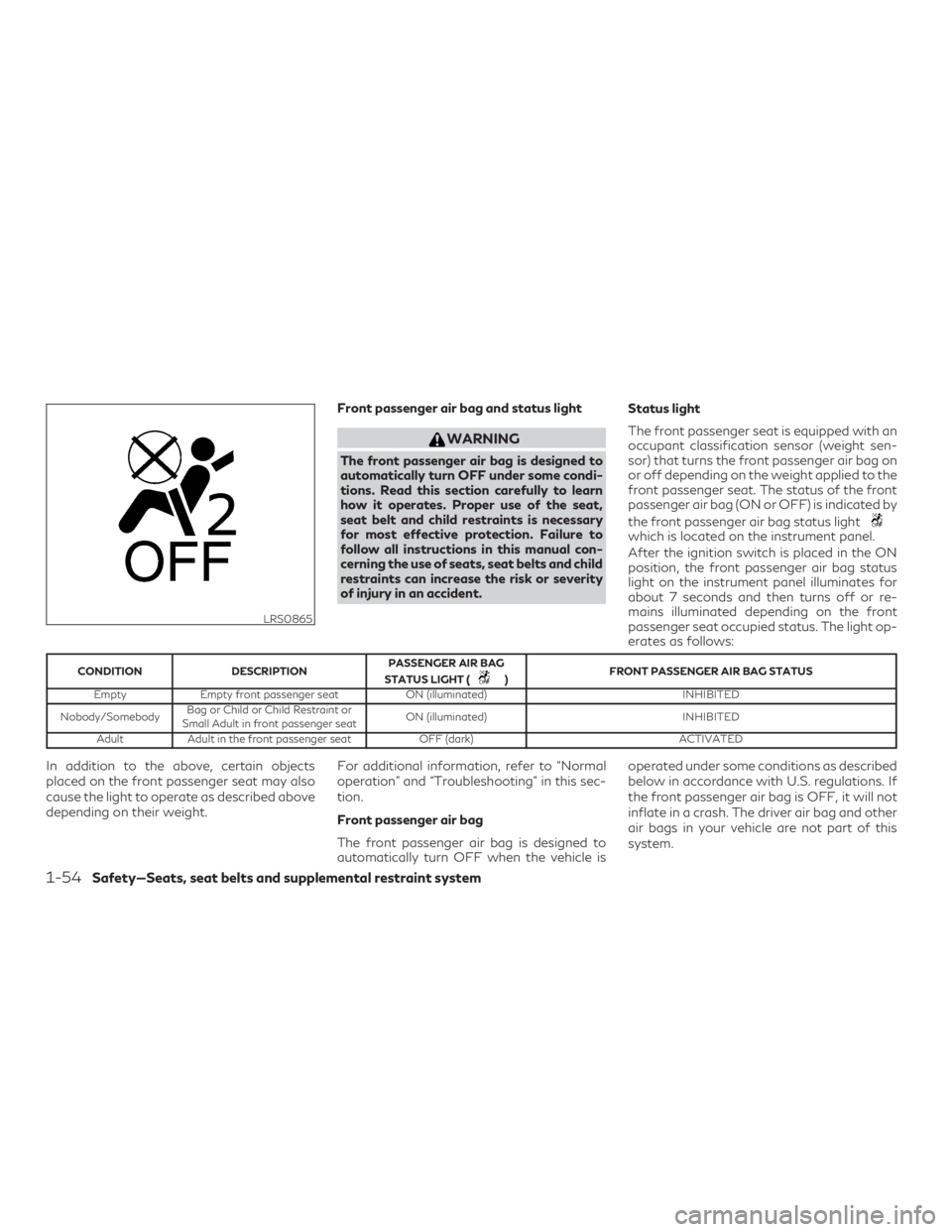
Front passenger air bag and status light
WARNING
The front passenger air bag is designed to
automatically turn OFF under some condi-
tions. Read this section carefully to learn
how it operates. Proper use of the seat,
seat belt and child restraints is necessary
for most effective protection. Failure to
follow all instructions in this manual con-
cerning the use of seats, seat belts and child
restraints can increase the risk or severity
of injury in an accident.Status light
The front passenger seat is equipped with an
occupant classification sensor (weight sen-
sor) that turns the front passenger air bag on
or off depending on the weight applied to the
front passenger seat. The status of the front
passenger air bag (ON or OFF) is indicated by
the front passenger air bag status light
which is located on the instrument panel.
After the ignition switch is placed in the ON
position, the front passenger air bag status
light on the instrument panel illuminates for
about 7 seconds and then turns off or re-
mains illuminated depending on the front
passenger seat occupied status. The light op-
erates as follows:
CONDITION
DESCRIPTION PASSENGER AIR BAG
STATUS LIGHT () FRONT PASSENGER AIR BAG STATUS
Empty Empty front passenger seat ON (illuminated) INHIBITED
Nobody/Somebody Bag or Child or Child Restraint or
Small Adult in front passenger seat ON (illuminated)
INHIBITED
Adult Adult in the front passenger seat OFF (dark) ACTIVATED
In addition to the above, certain objects
placed on the front passenger seat may also
cause the light to operate as described above
depending on their weight.For additional information, refer to “Normal
operation” and “Troubleshooting” in this sec-
tion.
Front passenger air bag
The front passenger air bag is designed to
automatically turn OFF when the vehicle isoperated under some conditions as described
below in accordance with U.S. regulations. If
the front passenger air bag is OFF, it will not
inflate in a crash. The driver air bag and other
air bags in your vehicle are not part of this
system.
LRS0865
1-54Safety—Seats, seat belts and supplemental restraint system
Page 81 of 580

The purpose of the regulation is to help re-
duce the risk of injury or death from an inflat-
ing air bag to certain front passenger seat
occupants, such as children, by requiring the
air bag to be automatically turned OFF. Cer-
tain sensors are used to meet the require-
ments.
The occupant classification sensor in this ve-
hicle is a weight sensor. It is designed to
detect an occupant and objects on the seat
by weight. For example, if a child is in the
front passenger seat, the INFINITI Advanced
Air Bag System is designed to turn the front
passenger air bag OFF in accordance with
the regulations. Also, if a child restraint of the
type specified in the regulations is on the
seat, its weight and the child’s weight can be
detected and cause the air bag to turn OFF.
Front passenger seat adult occupants who
are properly seated and using the seat belt as
outlined in this manual should not cause the
front passenger air bag to be automatically
turned OFF. For small adults it may be turned
OFF, however, if the occupant takes his/her
weight off the seat cushion (for example, by
not sitting upright, by sitting on an edge of
the seat, or by otherwise being out of posi-
tion), this could cause the sensor to turn the
air bag OFF. Always be sure to be seated andwearing the seat belt properly for the most
effective protection by the seat belt and
supplemental air bag.
INFINITI recommends that pre-teens and
children be properly restrained in a rear seat.
INFINITI also recommends that appropriate
child restraints and booster seats be properly
installed in a rear seat. If this is not possible,
the occupant classification sensor is designed
to operate as described above to turn the
front passenger air bag OFF for specified
child restraints as required by the regulations.
Failing to properly secure child restraints and
to use the ALR mode may allow the restraint
to tip or move in a collision or sudden stop.
This can also result in the passenger air bag
inflating in a crash instead of being OFF. For
additional information, refer to “Child re-
straints” in this section.
If the front passenger seat is not occupied,
the front passenger air bag is designed not to
inflate in a crash. However, heavy objects
placed on the seat could result in air bag
inflation, because of the object’s weight de-
tected by the occupant classification sensor.
Other conditions could also result in air bag
inflation, such as if a child is standing on the
seat, or if two children are on the seat, con-
trary to the instructions in this manual. Al-ways be sure that you and all vehicle occu-
pants are seated and restrained properly.
Using the front passenger air bag status light,
you can monitor when the front passenger air
bag is automatically turned OFF.
If an adult occupant is in the seat but the
front passenger air bag status light is illumi-
nated (indicating that the air bag is OFF), it
could be that the person is a small adult, or is
not sitting on the seat properly or not using
the seat belt properly.
If a child restraint must be used in the front
seat, the front passenger air bag status light
may or may not be illuminated, depending on
the size of the child and the type of child
restraint being used. If the air bag status light
is not illuminated (indicating that the air bag
might inflate in a crash), it could be that the
child restraint or seat belt is not being used
properly. Make sure that the child restraint is
installed properly, the seat belt is used prop-
erly and the occupant is positioned properly.
If the air bag status light is still not illumi-
nated, reposition the occupant or child re-
straint in a rear seat.
If the front passenger air bag status light will
not illuminate even though you believe that
the child restraint, the seat belts and the oc-
cupant are properly positioned, it is recom-
Safety—Seats, seat belts and supplemental restraint system1-55